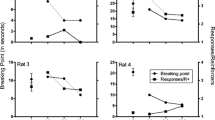Abstract
The effects of diprenorphine and naloxone were examined in squirrel monkeys responding under a multiple fixed-ratio 30, fixed-interval 5-min schedule of food presentation. Dose-response curves for diprenorphine and naloxone were determined prior to and following chronic administration of 10.0 mg/kg naloxone once daily for at least 21 days. Prior to the chronic regimen, naloxone (0.1–10.0 mg/kg) had little effect on performance. At the highest dose examined, rates of responding were decreased only slightly. Diprenorphine (0.003–0.1 mg/kg) produced dose-dependent decreases in rates of responding under both components of the multiple schedule. Subsequent to the chronic naloxone regimen, doses of both naloxone and diprenorphine produced greater decreases in rates of responding. This suggests that frequent exposure to naloxone enhances its own rate-decreasing effects as well as those of diprenorphine.
Similar content being viewed by others
References
Brown DR, Holtzman SG (1981) Narcotic antagonists attenuate drinking induced by water deprivation in a primate. Life Sci 28:1287–1294
Carter RB, Leander D (1982) Discriminative stimulus properties of naloxone. Psychopharmacology 77:305–308
Colwill RM, Rescorla RA (1985a) Postconditioning devaluation of a reinforcer affects instrumental responding. J Exp Psychol [Anim Behav] 11:120–132
Colwill RM, Rescorla RA (1985b) Instrumental responding remains sensitive to reinforcer devaluation after extensive training. J Exp Psychol [Anim Behav] 11:520–536
Cowan A (1973) Evaluation in non-human primates: evaluation of the physical dependence capacities of oripavine-thebaine partial agonists in patas monkeys. In: Braude MC, Harris LS, May EL, Smith JP, Villarreal JE (eds) Narcotic antagonists. Raven Press, New York, pp 427–438
Cowan A (1976) Use of the mouse-jumping test for estimating antagonist potencies of morphine antagonists. J Pharm Pharmacol 28:177–182
DeRossett SE, Holtzman SG (1984) Effects of naloxone, diprenorphine, buprenorphine and etorphine on unpunished and punished food-reinforced responding in the squirrel monkey. J Pharmacol Exp Ther 228:669–675
DeRossett SE, Holtzman SG (1986) Discriminative stimulus effects of the opioid antagonist diprenorphine in the squirrel monkey. J Pharmacol Exp Ther 237:437–444
Dingledine R, Iversen LL, Breukin E (1978) Naloxone as a GABA antagonist: evidence from iontophoretic, receptor binding and convulsant studies. Eur J Pharmacol 47:19–27
Dykstra LA (1983a) Development of enhanced sensitivity to naloxone. Life Sci 33:2079–2089
Dykstra LA (1983b) Behavioral effects of buprenorphine and diprenorphine under a multiple schedule of food presentation. J Pharmacol Exp Ther 226:317–323
Dykstra LA, McMillan DE, Harris LS (1974) Antagonism of morphine by long-acting narcotic antagonists. Psychopharmacologia 39:151–162
France CP, Woods JH (1985) Opiate agonist-antagonist interactions: application of a three-key drug discrimination procedure. J Pharmacol Exp Ther 234:81–89
Gallagher M, King RA, Young NA (1983) Opioid antagonists improve spatial memory. Science 221:975–976
Goldberg SR, Morse WH, Goldberg DM (1976) Some behavioral effects of morphine, naloxone and nalorphine in the squirrel monkey and the pigeon. J Pharmacol Exp Ther 196:625–636
Goldberg SR, Morse WH, Goldberg DM (1981) Acute and chronic effects of naltrexone and naloxone on schedule-controlled behavior of squirrel monkeys and pigeons. J Pharmacol Exp Ther 216:500–509
Herman BH, Holtzman SR (1984) Repeated administration of naltrexone and diprenorphine decreases food intake and body weight in squirrel monkeys. Life Sci 34:1–12
Kelleher RT, Goldberg SR (1979) Effects of naloxone on schedule-controlled behavior in monkeys. In: Usdin E, Bunney WE, Kline NS (eds) Endorphins in mental health research. Oxford University Press, New York, pp 461–472
Kosterlitz HW, Waterfield AA, Berthoud V (1973) Assessment of the agonist and antagonist properties of narcotic analgesic drugs by their actions on the morphine receptor in the guinea pig ileum. In: Braude MC, Harris LS, May EL, Smith JP, Villarreal JE (eds) Narcotic antagonists. Raven Press, New York, pp 319–334
Locke KW, Brown DR, Holtzman SG (1982) Effects of opiate antagonists and putative mu- and kappa-agonists on milk intake in rat and squirrel monkey. Pharmacol Biochem Behav 17:1275–1279
Panksepp J, Bishop P (1981) An autoradiographic map of (H3)diprenorphine binding in rat brain: effects of social interaction. Brain Res Bull 7:405–410
Sadee W, Perry DC, Rosenbaum JS, Herz A (1982) (H3)Diprenorpine receptor binding in vivo and in vitro. Eur J Pharmacol 81:431–440
Sawynok J, Pinsky C, Labella FS (1979) Minireview on the specificity of naloxone as an opiate antagonist. Life Sci 25:1621–1632
Schulz R, Wuster M, Herz A (1979) Supersensitivity to opioids following the chronic blockade of endorphin action by naloxone. Naunyn-Schmiedeberg's Arch Pharmacol 306:93–96
Snell D, Feller D, Bylund D, Harris RA (1982) Sensitization produced by repeated administration of naloxone is blocked by food deprivation. J Pharmacol Exp Ther 221:444–452
Spealman RD, Kelleher RT, Goldberg DM, Goldberg SR, Hakansson CG (1979) Supersensitivity to the behavioral effects of naloxone and naltrexone after chronic administration in rhesus monkeys. Fed Proc 38:741
Spealman RD, Kelleher RT, Morse WH, Goldberg SR (1981) Supersensitivity to the behavioral effects of opiate antagonists. Psychopharmacol Bull 17:54–56
Stolerman IP, Pilcher CWT, D'Mello GD (1978) Stereospecific aversive property of narcotic antagonists in morphine-free rats. Life Sci 22:1755–1762
Valentino RJ, Herling S, Woods JH (1981) Supersensitivity and the dependent state: The relationship between the acute behavioral effects of narcotic antagonists and the narcotic-dependent state. Psychopharmacol Bull 17:51–54
Warren PA, Morse WH (1985) Effects of quaternary naltrexone and chlordiazepoxide in squirrel monkeys with enhanced sensitivity to the behavioral effects of naltrexone. J Pharmacol Exp Ther 235:412–417
Young A (1986) Effects of acute morphine pretreatment on the rate-decreasing and antagonist activity of naloxone. Psychopharmacology 88:201–208
Author information
Authors and Affiliations
Rights and permissions
About this article
Cite this article
Oliveto, A.H., Dykstra, L.A. Diprenorphine and naloxone in squirrel monkeys with enhanced sensitivity to opioid antagonists. Psychopharmacology 95, 339–343 (1988). https://doi.org/10.1007/BF00181944
Received:
Revised:
Issue Date:
DOI: https://doi.org/10.1007/BF00181944




